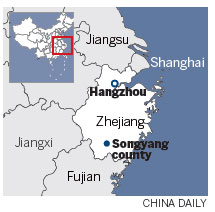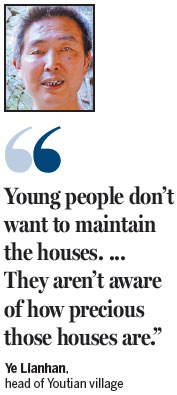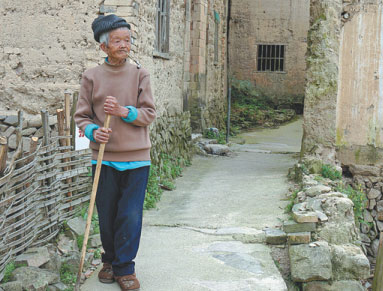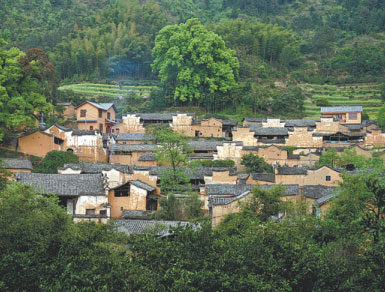Preserving the past to finance the future
Updated: 2015-05-07 07:43
By Yan Yiqi(China Daily)
|
|||||||||||
Officials in rural areas are pondering ways of boosting visitor numbers to prevent some of China's oldest settlements from dying out. However, the plans may produce as many problems as they solve, and change the character of the villages irrevocably. Yan Yiqi reports from Songyang, Zhejiang province.
In the mountainous Southwestern region of Zhejiang province lies Songyang, a county containing more than 100 traditional villages whose geographical isolation has preserved their traditional charm and maintained a style of farming that has been used for centuries.
While most Chinese cities are dominated by tall concrete buildings, the villages in Songyang, with their distinctive yellow mud walls, black and gray roofs and abundant trees, retain an air of unhurried tranquility.
There's a twist, of course. Although the villages attract large numbers of visitors, such as artists and photography students, they are in danger of dying out, just as many ancient settlements across the country have done.
Youtian village has a history of more than 350 years, and nine of the houses are more than 250 years old. However, as an increasing number of young people left to search for work in the big cities, the village population dwindled and the houses fell into disrepair.
Ye Lianhan, head of the village, has witnessed the decline of his home village. "When I was a child, it was a small but very lively village. The houses linked with each other so I could visit my friend's yard by passing the kitchen of my neighbor," the 53-year-old said. "The wisdom of our ancestors was far beyond our imagination. Take the drainage system for example; the water in my yard never gets deeper than 10 centimeters no matter how hard the rain is."
Although more than 300 people are registered as living in the village, fewer than 100 actually live there permanently, and most of them are elderly. "The most common situation is that three or four seniors will live together in a house of 600 to 700 square meters, but they aren't capable of maintaining the buildings," he said.
Ye's 81-year-old father lives alone in one of the 250-year-old houses. Several years ago, part of the house collapsed and two stone pillars were stolen, and the walls are now cracked. Even so, it's still one of the best-preserved houses in the village.
"Young people don't want to maintain the houses. They would rather set them on fire and burn them down so that they can claim grants to build new ones. They aren't aware of how precious those houses are," Ye said.
He has been considering refurbishing the houses for years, but neither he nor the village has access to the large amount of money the construction work would cost.
The same story can be heard in many of the other villages in Songyang.
Song Renjian, director of the Yangjiatang Village Administrative Committee, said it costs more to refurbish an old house than to build a new one.
"We have to maintain the original look and structure of the houses, while also solving problems such as making them burglarproof and providing sanitary facilities. Also, very few workers are capable of handling projects such as this," he said.
Preserve and protect
Youtian and Yangjiatang are two of 50 villages in Songyang that have been listed as traditional Chinese villages - those with cultural and historical features worth preserving and protecting - by the ministries of culture, finance, and housing and urban-rural development. By January, 2,555 villages across China had been added to the list.
Huo Xiaowei, editor-in-chief of Traditional Chinese Villages Bulletin, said it will be difficult to pass these villages down to the coming generations.
"The conservation and development of China's historic villages has been seriously threatened and faced enormous challenges during the rapid economic development that has occurred in China in the past few decades. The expected increase in the urbanization rate from 53.7 percent in 2013 to 70 percent in 2030 means many villages, including some historic ones, face the prospect of being demolished," he said.
In response, Songyang has moved to develop and protect the village. Last year, reconstruction projects, costing a total of about 20 million yuan ($3.2 million), started in more than 20 villages, including Youtian and Yangjiatang.
Wang Jun, Songyang's magistrate, said that the plan is to protect these ancient villages by developing tourism.
"To encourage villagers to stay and renovate the old houses, we need to offer them sufficient income. Tourism seems to cause the least harm to the environment," he said.
Luo Deyin, professor of architecture at Tsinghua University in Beijing, has participated in the reconstruction of two historic houses in Songyang's Pingtian village. He supports the plan to save the villages through tourism.
Luo, who has worked on reconstruction projects in traditional villages in several provinces, said the ancient villages will quickly die if the infrastructure for basic tourism isn't put in place.
"Currently, the simplest and most effective way of helping a traditional village to survive in a time of rapid urbanization is the development of local tourism," he said, adding that tourism brings outsiders to the villages, creating opportunities for them to make contact with the residents.
"This will eventually alter the villagers' views of their cultural relics, and they will try to protect them instead of tearing them down," he said.
Young people return
The change is about to be made in Pingtian. Jiang Binlong, general manager of the local development project, said that reconstruction work has lured about 30 young people to return to the village to live and work. The move has raised their standards of living. Their average earnings in the city used to be 2,000 to 3,000 yuan a month, but now they can earn 150 yuan a day, so their monthly income is now about 4,500 yuan.
Further down the line, the villagers expect to earn a living by running guesthouses and providing other tourist-related services.
Two refurbished buildings that will serve as guesthouses and offer 10 rooms costing 380 to 580 yuan a night are scheduled to open in early May. The original structures have been retained, but more glass has been added to admit as much light as possible. By the end of May, the village will boast a further six hotels and a hostel.
In addition to Luo's team, Songyang is also playing host to four other groups of architectural experts working on the reconstruction project.
Pingtian has attracted teams - from Tsinghua University, the China Central Academy of Fine Arts and the University of Hong Kong - that are working to transform the ancient settlement into a tourist village. By the end of May, Pingtian will have eight more guesthouses and a hostel.
Jiang said the local tourist activities will focus on agriculture. "There will be a tea-picking workshop and land for tourists to plant their own vegetables," he said.
Although far from fully developed, Songyang earned 811 million yuan from the 1.88 million tourists who visited the county last year.
Despite that success, Wang is hopeful that tourist numbers can be kept to manageable levels. He said he has seen the results of the overexploitation of traditional towns and villages where commercial activities have become dominant and the places have lost their original characteristics.
"I don't want to see buses full of tourists coming to our villages, because we don't have the capacity to handle large numbers of people. Instead, we should provide the villages with a stimulus and allow them to develop quietly," he said.
Contact the writer at yanyiqi@chinadaily.com.cn


|
An artist paints the distinctive houses of Youtian village in Songyang county, Zhejiang province. Provided to China Daily |
|
An elderly resident relaxes in Yangjiatang village in Songyang. |
|
A bird's-eye view of Yangjiatang village. Photos by Yan Yiqi / China Daily |
(China Daily 05/07/2015 page6)
Today's Top News
China pledges continued help as Nepal rebuilds
Rolling stock company forges ahead in Russia
Denmark receives 3 bomb threats in one day: media
Bilateral efforts 'inject fresh impetus'
Chinese researcher wins Heinz Maier-Leibnitz Prize in Germany
Reasons behind Russia's high-profile V-Day celebrations
Wang Jianlin: Asia's richest man
China regulator denies Siemens bribery probe
Hot Topics
Lunar probe , China growth forecasts, Emission rules get tougher, China seen through 'colored lens', International board,
Editor's Picks

|

|

|

|

|

|









